SBOS761 November 2015 OPA2211-EP
PRODUCTION DATA.
- 1 Features
- 2 Applications
- 3 Description
- 4 Revision History
- 5 Pin Configuration and Functions
- 6 Specifications
- 7 Detailed Description
- 8 Application and Implementation
- 9 Power Supply Recommendations
- 10Layout
- 11Device and Documentation Support
- 12Mechanical, Packaging, and Orderable Information
パッケージ・オプション
メカニカル・データ(パッケージ|ピン)
- DRG|8
サーマルパッド・メカニカル・データ
- DRG|8
発注情報
6 Specifications
6.1 Absolute Maximum Ratings
over operating free-air temperature range (unless otherwise noted)(1)| MIN | MAX | UNIT | |||
|---|---|---|---|---|---|
| Supply voltage | VS = (V+) – (V–) | 40 | V | ||
| Input voltage | (V–) – 0.5 | (V+) + 0.5 | V | ||
| Input current (any pin except power-supply pins) | –10 | 10 | mA | ||
| Output short-circuit(2) | Continuous | ||||
| Junction temperature, TJ | 150 | °C | |||
| Storage temperature, Tstg | –65 | 150 | °C | ||
(1) Stresses beyond those listed under Absolute Maximum Ratings may cause permanent damage to the device. These are stress ratings only, which do not imply functional operation of the device at these or any other conditions beyond those indicated under Recommended Operating Conditions. Exposure to absolute-maximum-rated conditions for extended periods may affect device reliability.
(2) Short-circuit to VS / 2 (ground in symmetrical dual supply setups), one amplifier per package.
6.2 ESD Ratings
| VALUE | UNIT | |||
|---|---|---|---|---|
| V(ESD) | Electrostatic discharge | Human-body model (HBM), per ANSI/ESDA/JEDEC JS-001(1) | ±3000 | V |
| Charged-device model (CDM), per JEDEC specification JESD22-C101(2) | ±1000 | |||
(1) JEDEC document JEP155 states that 500-V HBM allows safe manufacturing with a standard ESD control process.
(2) JEDEC document JEP157 states that 250-V CDM allows safe manufacturing with a standard ESD control process.
6.3 Recommended Operating Conditions
over operating free-air temperature range (unless otherwise noted)| MIN | NOM | MAX | UNIT | |
|---|---|---|---|---|
| Supply voltage (V+ – V–) | 4.5 (±2.25) | 36 (±18) | V | |
| Operating temperature, TJ | –55 | 125 | °C |
6.4 Thermal Information
| THERMAL METRIC(1) | OPA2211-EP | UNIT | |
|---|---|---|---|
| DRG (WSON) | |||
| 8 PINS | |||
| RθJA | Junction-to-ambient thermal resistance | 47.3 | °C/W |
| RθJC(top) | Junction-to-case (top) thermal resistance | 51.8 | °C/W |
| RθJB | Junction-to-board thermal resistance | 21.8 | °C/W |
| ψJT | Junction-to-top characterization parameter | 0.7 | °C/W |
| ψJB | Junction-to-board characterization parameter | 21.9 | °C/W |
| RθJC(bot) | Junction-to-case (bottom) thermal resistance | 4.2 | °C/W |
(1) For more information about traditional and new thermal metrics, see the Semiconductor and IC Package Thermal Metrics application report, SPRA953.
6.5 Electrical Characteristics: VS = ±2.25 to ±18 V
at TJ = 25°C, RL = 10 kΩ connected to midsupply, VCM = VOUT = midsupply, unless otherwise noted.| PARAMETER | TEST CONDITIONS | MIN | TYP | MAX | UNIT | |||
|---|---|---|---|---|---|---|---|---|
| OFFSET VOLTAGE | ||||||||
| Input offset voltage | VOS | VS = ±15 V | ±50 | ±175 | μV | |||
| Over temperature | TJ = –55°C to 125°C | ±350 | µV | |||||
| Drift | dVOS/dT | TJ = –55°C to 125°C | 0.35 | μV/°C | ||||
| vs power supply | PSRR | VS = ±2.25 V to ±18 V | 0.1 | 1 | μV/V | |||
| Over temperature | 3 | μV/V | ||||||
| INPUT BIAS CURRENT | ||||||||
| Input bias current | IB | VCM = 0 V, TJ = –55°C to 125°C | ±50 | ±350 | nA | |||
| Offset current | IOS | VCM = 0 V, TJ = –55°C to 125°C | ±20 | ±200 | nA | |||
| NOISE | ||||||||
| Input voltage noise | en | ƒ = 0.1 Hz to 10 Hz | 80 | nVPP | ||||
| Input voltage noise density | ƒ = 10 Hz | 2 | nV/√Hz | |||||
| ƒ = 100 Hz | 1.4 | nV/√Hz | ||||||
| ƒ = 1 kHz | 1.1 | nV/√Hz | ||||||
| Input current noise density | In | ƒ = 10 Hz | 3.2 | pA/√Hz | ||||
| ƒ = 1 kHz | 1.7 | pA/√Hz | ||||||
| INPUT VOLTAGE RANGE | ||||||||
| Common-mode voltage range | VCM | VS ≥ ±5 V | (V–) + 1.8 | (V+) – 1.4 | V | |||
| VS < ±5 V | (V–) + 2 | (V+) – 1.4 | V | |||||
| Common-mode rejection ratio | CMRR | VS ≥ ±5V, (V–) + 2V ≤ VCM ≤ (V+) – 2V, TJ = –55°C to 125°C | 114 | 120 | dB | |||
| VS < ±5V, (V–) + 2V ≤ VCM ≤ (V+) – 2V, TJ = –55°C to 125°C | 106 | 120 | dB | |||||
| INPUT IMPEDANCE | ||||||||
| Differential | 20k || 8 | Ω || pF | ||||||
| Common-mode | 109 || 2 | Ω || pF | ||||||
| OPEN-LOOP GAIN | ||||||||
| Open-loop voltage gain | AOL | (V–) + 0.2 V ≤ VO ≤ (V+) – 0.2V, RL = 10 kΩ, TJ = –55°C to 125°C |
114 | 130 | dB | |||
| (V–) + 0.6 V ≤ VO ≤ (V+) – 0.6 V, RL = 600 Ω |
110 | 114 | dB | |||||
| Over temperature | AOL | (V–) + 0.6 V ≤ VO ≤ (V+) – 0.6V, IO ≤ 15 mA, TJ = –55°C to 125°C |
100 | dB | ||||
| FREQUENCY RESPONSE | ||||||||
| Gain-bandwidth product | GBW | G = 100 | 80 | MHz | ||||
| G = 1 | 45 | MHz | ||||||
| Slew rate | SR | 27 | V/μs | |||||
| Settling time, 0.01% | tS | VS = ±15 V, G = –1, 10-V step, CL = 100 pF | 400 | ns | ||||
| 0.0015% (16-bit) | VS = ±15 V, G = –1, 10-V step, CL = 100 pF | 700 | ns | |||||
| Overload recovery time | G = –10 | 500 | ns | |||||
| Total harmonic distortion + noise | THD+N | G = +1, ƒ = 1kHz, VO = 3VRMS, RL = 600 Ω |
0.000015% | |||||
| –136 | dB | |||||||
| OUTPUT | ||||||||
| Voltage output | VOUT | RL = 10 kΩ, AOL ≥ 114 dB, TJ = –55°C to 125°C | (V–) + 0.2 | (V+) – 0.2 | V | |||
| RL = 600 Ω, AOL ≥ 110 dB | (V–) + 0.6 | (V+) – 0.6 | V | |||||
| IO < 15 mA, AOL ≥ 100 dB, TJ = –55°C to 125°C | (V–) + 0.6 | (V+) – 0.6 | V | |||||
| Short-circuit current | ISC | +30/–45 | mA | |||||
| Capacitive load drive | CLOAD | See Typical Characteristics | pF | |||||
| Open-loop output impedance | ZO | ƒ = 1MHz | 5 | Ω | ||||
| POWER SUPPLY | ||||||||
| Specified voltage | VS | ±2.25 | ±18 | V | ||||
| Quiescent current (per channel) | IQ | IOUT = 0 A | 3.6 | 4.5 | mA | |||
| Over temperature | TJ = –55°C to 125°C | 6 | mA | |||||
| TEMPERATURE RANGE | ||||||||
| Operating range | TJ | –55 | 125 | °C | ||||
6.6 Typical Characteristics
At TJ = 25°C, VS = ±18 V, and RL = 10 kΩ, unless otherwise noted.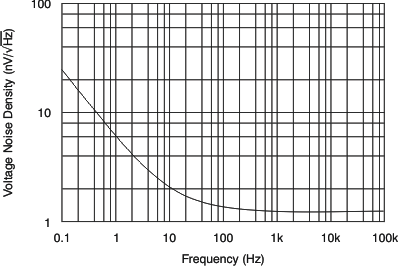
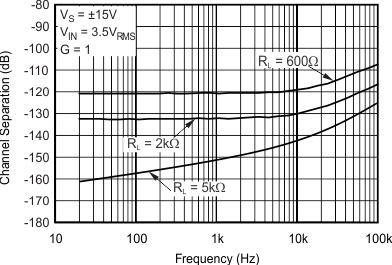
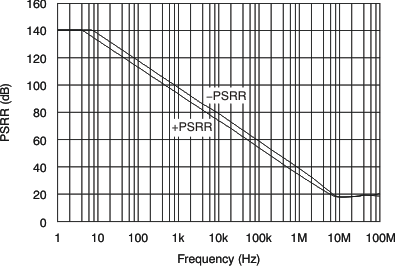
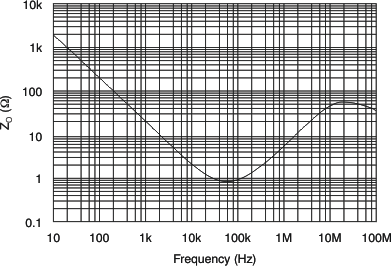
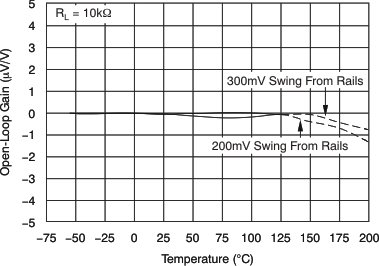
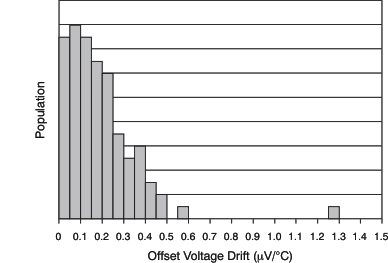
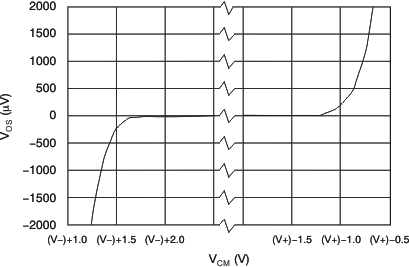
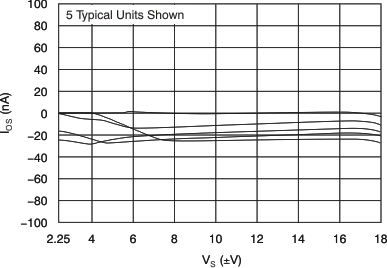
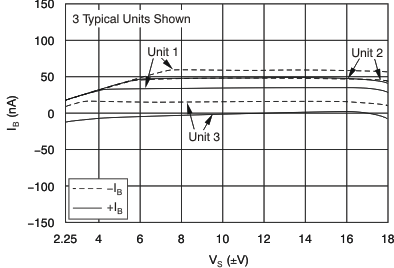
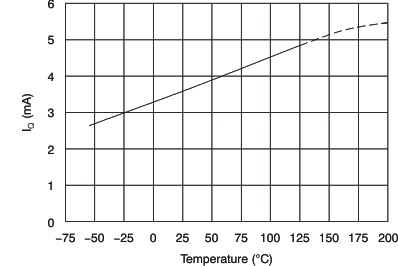
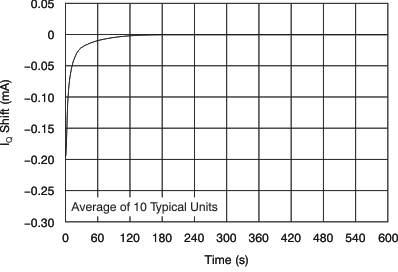
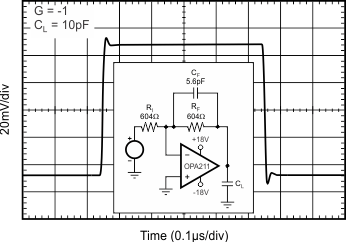
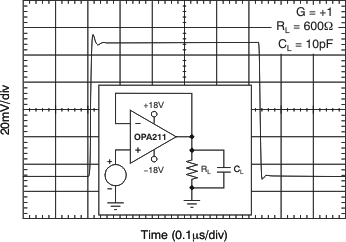
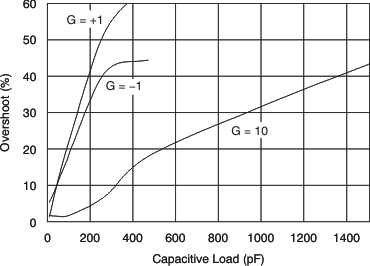 Figure 27. Small-Signal Overshoot vs Capacitive Load
Figure 27. Small-Signal Overshoot vs Capacitive Load (100-mV Output Step)
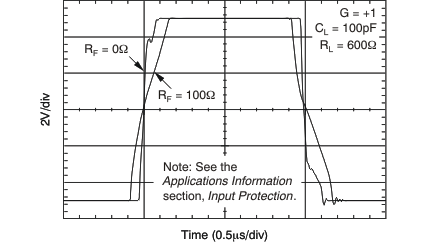
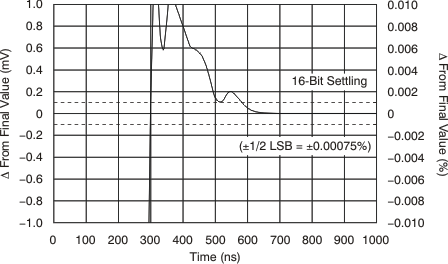
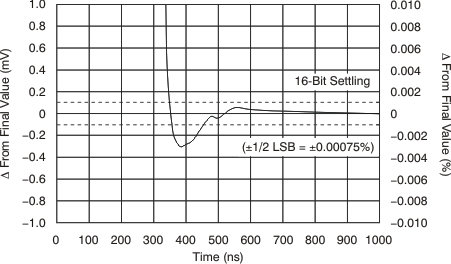
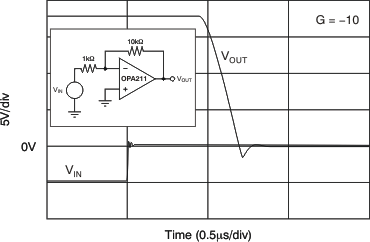
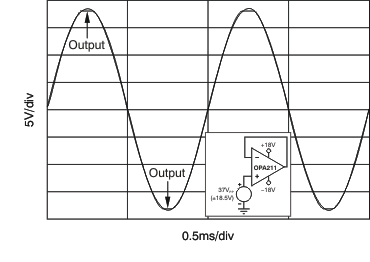
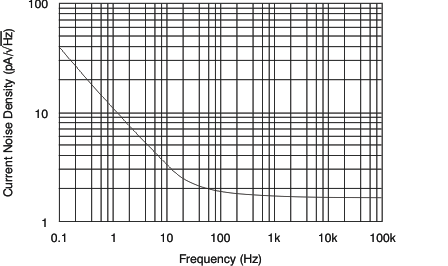
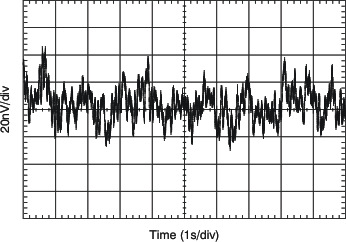
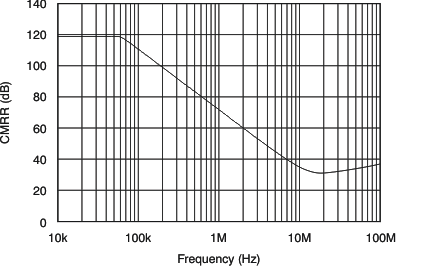
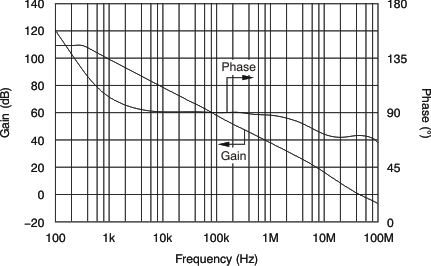
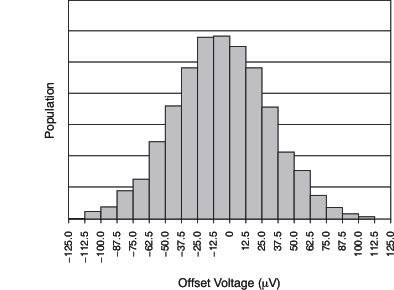 Figure 10. Offset Voltage Production Distribution
Figure 10. Offset Voltage Production Distribution
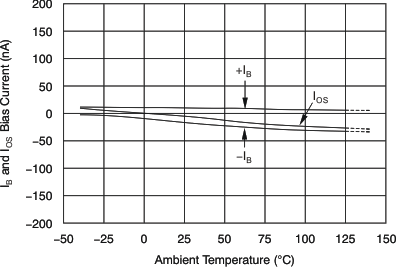
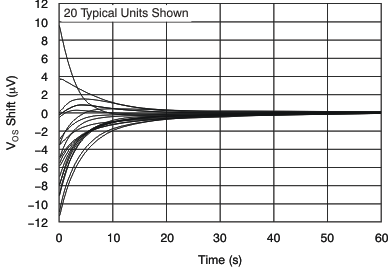
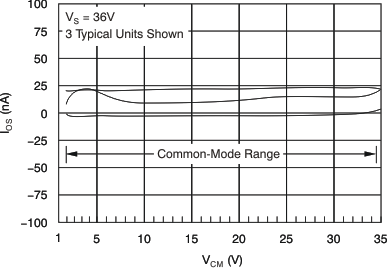
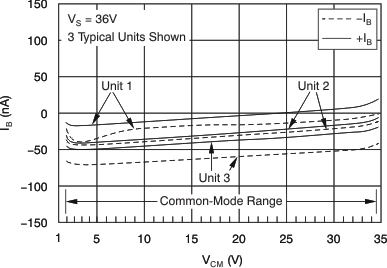
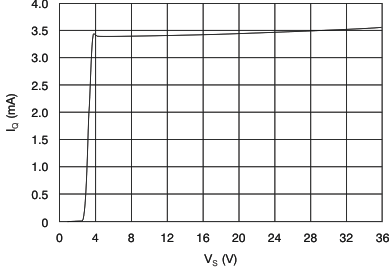
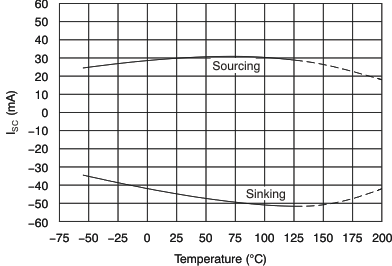
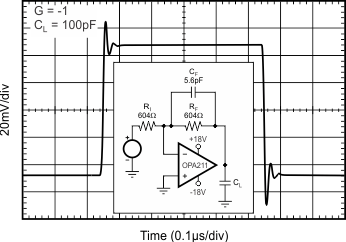
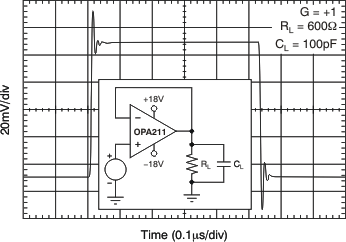
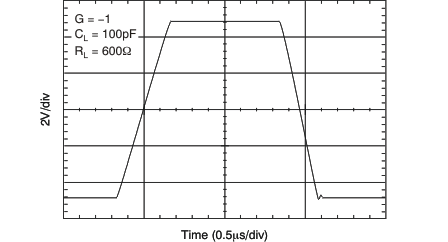
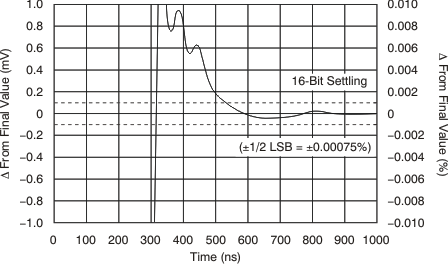 Figure 30. Large-Signal Positive Settling Time
Figure 30. Large-Signal Positive Settling Time(10 VPP, CL = 100 pF)
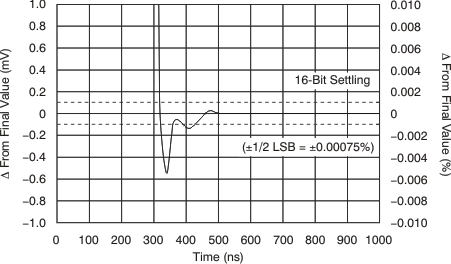
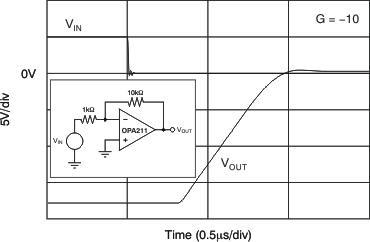
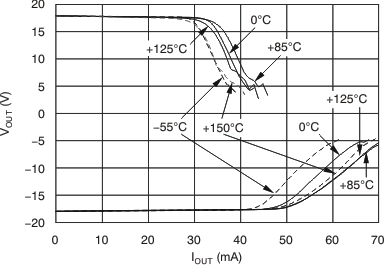 Figure 36. Output Voltage vs Output Current
Figure 36. Output Voltage vs Output Current